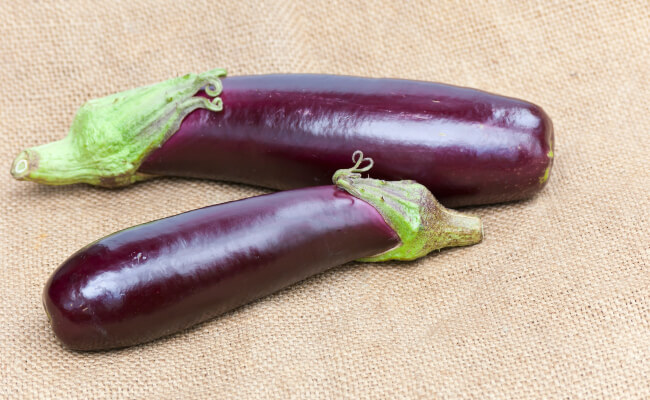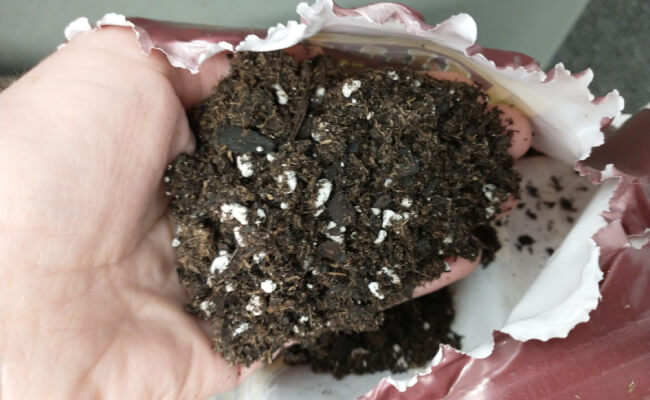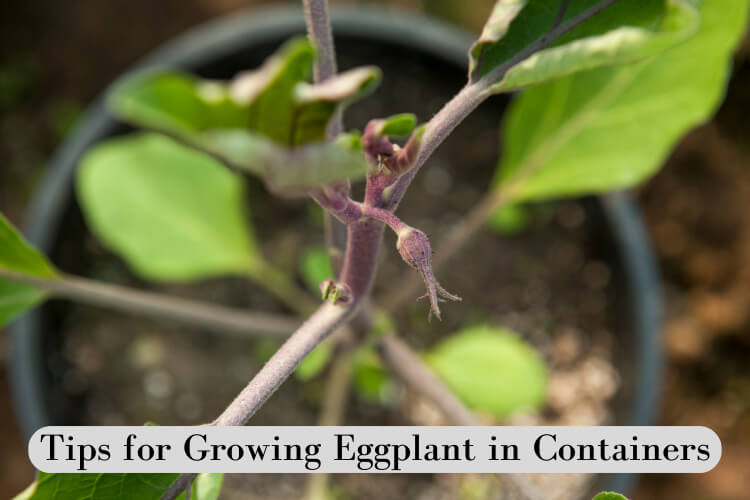You’ve decided to try your hand at growing eggplant in containers- good for you! Whether you’re like me and don’t have a ton of ground space or you just love the convenience of container veggies, planting eggplant in pots is a great way to enjoy a fresh harvest in a smaller footprint.
But growing eggplant in a pot definitely requires some know-how. In this post, you’ll learn how to recognize a good eggplant container size, which varieties will grow happily in a pot, and how to care for your eggplants.
Let’s get started!
Key Points:
- Compact eggplant varieties are ideal for container gardening. Fairy Tale, Hansel, Patio Baby, and Little Fingers are some good options.
- Choose a container that has at least 5 gallons of soil capacity. If you want to grow two eggplants in the same container, choose one that’s at least 20 inches in diameter and 12 inches deep.
- Fill containers with high-quality potting mix that drains well and is rich in nutrients.
- Make sure potted eggplants get at least 6 hours of sun daily, water whenever the soil is dry 1-2 inches deep, fertilize every 2-3 weeks, and use a support structure to keep the plant upright and stable.
Table of Contents
Best Varieties of Eggplant for Container Gardening
In my opinion, the essential key to successfully growing eggplants in containers- even above the right pot or soil- is choosing the right variety.
Eggplant plants can get big- according to The University of Arizona Extension Office, mature plants can get up to 8 feet tall! But that incredible size is probably limited to eggplants growing in tropical areas of the world, where they’re a perennial crop.
For those of us outside the tropics, eggplant is treated as an annual. It will probably max out at 3-4 feet in height, and the root system for standard eggplant varieties can be 3 feet deep. So that’s still too big for most containers (excluding large raised beds).
What you want for freestanding pots and containers are dwarf or compact eggplant varieties. These cultivars typically don’t get more than about 30 inches tall, and they also produce smaller fruit that won’t topple a container-bound plant over as easily.
Here are a few varieties I recommend for container growing.
Fairy Tale

If there was ever an eggplant variety that’s perfect for container growing, it’s Fairy Tale. This dwarf eggplant reaches 30 inches in height maximum, and they produce multiple fruits that get up to 4 inches long. Fairy Tale fruits have a delicate flavor and a lovely purple-and-white striped skin color, and they’ll be ready for harvest around 50 days after transplanting.
Buy Fairy Tale eggplant seeds here: True Leaf Market
Hansel

Hansel eggplants are a hybrid that’s been bred to yield sweet fruits that get about 4-5 inches in length. And you’ll get a lot of harvest from one plant- Hansel produces abundant clusters of long, narrow fruits. Expect to harvest Hansel eggplants about 55-60 days after transplanting into the garden.
Buy Hansel eggplant seeds here: Johnny’s Selected Seeds
Patio Baby

As the name suggests, these little eggplants are perfect for a container on your patio. Of all the varieties we’ve looked at so far, Patio Baby eggplants are the ones that most closely resemble common Italian eggplants.
Patio Baby is a fast grower that should be ready for picking in about 50 days after transplanting. The plants only get up to 24 inches tall, and they produce mini fruits about 2-3 inches in length. Another nice thing is that Patio Baby doesn’t have poky spines- so no gloves needed to handle them!
Buy Patio Baby eggplant seeds: Johnny’s Selected Seeds
Little Finger

Little Fingers eggplant produces several clusters of elongated fruits, each one reaching a length of about 4-5 inches long. They really do look like little fingers hanging on the plant!
The skins are very tender, so no need to peel your Little Fingers eggplants before cooking them. The plant can grow to a maximum height of about 30 inches, and the fruits are ready for harvest about 70 days after transplanting.
Buy Little Fingers eggplant seeds: True Leaf Market
What’s the Right Eggplant Container Size?
Even with compact varieties, you’re still going to have a pretty large plant on your hands once your eggplant reaches its mature stage. So 6-inch pots won’t cut it here.
Choose a pot that’s at least 12 inches in diameter- and if you can get your hands on a bigger one, do so. A food-safe 5-gallon can also work well, and 5-gallon or larger grow bags are another option. That’s enough space to grow one eggplant in each container.
If you want to grow two eggplants together in a single container, choose one that’s at least 20 inches in diameter and at least 12 inches deep. Again, bigger is always better. A wooden half-barrel is a good option, and large plastic pots will also work.
Best Soil for Container Eggplant
One great thing about container gardening is that you get full control over the soil you put in your pots- when planting straight into the ground, you’re far more limited by the soil’s natural condition.
Eggplants need loose soil that drains well and is rich in organic matter. Do not use soil that you’ve taken from the ground or any bagged soil labeled “topsoil” or “garden soil.” These are far too heavy and will just become a hard brick in your pots and containers.
Instead, you want potting soil. There are many brands of high-quality brands out there- these are a couple of my personal favorites.
Fox Farm Happy Frog has a great, light texture that I’ve found plants to thrive in. There are also beneficial microbes that help your eggplant absorb and process nutrients efficiently, and earthworm castings and bat guano provide natural fertilizer.

There are a couple of other soils I’ve also used in the past with good results:
NOTE: I’ve included links to buy soil online, but I always recommend checking in at your local garden center first. You might find the same product for less, and you won’t have to pay shipping charges that way.
I’ve also made my own potting soil mix before. One year, I made a blend of roughly 1 part hydrated coco coir to 1 part aged manure, with a couple of handfuls of perlite mixed in.
How to Grow Eggplant In a Pot
Now that you’ve got all the prep work done, let’s get down to the how-to.
I’ve covered the details in my comprehensive guide to growing eggplants, so in this post, I’ll stick to the specifics of container gardening.
When to Plant Eggplant Seeds and Seedlings
You can either grow your eggplant from seed or plant seedlings you buy from the garden center or get from another gardener.
It’s definitely easier to start with an established seedling, but you’re more limited on which varieties you can find. Some of the compact varieties I recommended above are a little more obscure, and you might not find seedlings for them. So if you’ve got your heart set on growing a certain variety, you’ll probably need to start from seed.
Planting seeds. In USDA zones 10-12, the growing season is long enough for you to start your eggplant seeds outdoors right in the container they’ll live in all summer.
But if you live in a lower zone, start your seeds indoors roughly 6-8 weeks before your last predicted frost date. Eggplant seeds need lots of warmth, humidity, and time (up to two weeks) to sprout.
Once your seedlings are 4-6 inches tall, have at least 4 sets of true leaves, and temperatures are consistently above 65 degrees Fahrenheit, start gradually transitioning them from the sheltered indoor conditions to the harsher outdoor ones. This is called hardening off, and it will take several days to acclimate your plants by increasing the length of time outdoors every day.
NOTE: Seedlings from a garden center are already hardened off and are ready for planting right away.
Planting seedlings. Dig a hole a few inches deep, and carefully remove your eggplant seedling from its seed tray. Set the seedling into the hole, and backfill with soil. Gently tamp the soil down to anchor the seedling, and water well.
Sunlight Needs
Set up your eggplant-growing container in a location where it will get at least 6 hours of full sun each day.
But do be aware that there can be too much of a good thing- harsh midday sun in the middle of a heat wave can scald your eggplants. If that’s in the forecast, move your eggplant container to a shadier location during the afternoon or set up a temporary shade structure if the container is too large to move easily. This video from The Rusted Garden provides a good demonstration of using shade cloth:
Watering Routine
Watering is one area where container growing can vary quite a bit from in-ground gardening. Since they hold a smaller soil volume, potted eggplants almost always dry out faster and need more frequent watering.
Check the soil moisture daily or two. Insert your finger into the soil 1-2 inches down. If it feels dry, give a long, soaking watering; if you still feel moisture, check again tomorrow.
Fertilizing Routine
Eggplants are heavy feeders, meaning that they need lots of nutrients to produce fruits. And that’s especially true when you’re growing eggplant in containers- potted plants can’t access naturally-occurring nutrients in the native soil, and frequent watering washes away the ones that are there.
Give your eggplant a balanced vegetable fertilizer every 2-4 weeks during the growing season. Granular or liquid formulas work equally well, although I’m partial to granules just because I think they’re easier to use.
Anything labeled as a tomato fertilizer will work wonderfully; follow the package directions for dosing.
Providing Support
While a max height of 30 inches for compact eggplants isn’t very tall, it wouldn’t hurt anything to provide your plant with some support to keep it upright.
A small tomato cage would be the easiest solution. I put tomato cages in 5-gallon buckets every year, and even large cages fit great. Another option is a sturdy dowel rod or wooden stake driven into the soil down to the bottom of the pot.
Whichever support structure you choose, place it as soon as you plant your seedlings to avoid damaging the roots.
Pruning
Pruning isn’t as essential to eggplants as it is to other veggies, like tomatoes and pumpkins. So if you don’t feel that your plant has an overabundance of side shoots and foliage, it’s fine if you don’t trim anything off. And that’s especially true of the dwarf varieties we choose when container gardening.
But cutting off the low branches and leaves can be helpful if your plant is putting out too much foliage and not much fruit. If that’s the case, also double-check your fertilizer to make sure you’re not using a high-nitrogen formula.
Potential Problems for Eggplant in Containers
One reason I like container gardening is that it’s easier to keep an eye on individual plants, so hopefully you can spot and treat problems early on. Here are some issues you may run into when growing eggplant in pots.
Pest Identification and Management
Unfortunately, eggplant can be a target for some common garden pests. Be on the lookout for these in particular:
- Flea beetles
- Colorado potato beetle
- Tomato hornworm
Flea beetle. Flea beetles are small jumping insects that are black in color and tend to appear in groups.

They eat foliage and can decimate an eggplant (along with many other types of plants) in a short time.
Spinosad soap and pyrethrin spray are effective to kill flea beetles, and they are both approved for organic gardening. Diatomaceous earth is also lethal; it is a desiccant that kills flea beetle through dehydration. But you’ll have to reapply it after every rainfall or watering session.
Colorado potato beetle. Potatoes are close relatives of eggplant, and Colorado potato beetles will happily take the opportunity to feast on eggplant leaves.

If you spot Colorado potato beetles on your eggplant, remove them manually and drop them into a cup of soapy water. Picking off potato beetles used to be one of my jobs as a child in my parent’s garden- but we dropped the beetles into a cup of gasoline instead. Thankfully, soapy water is just as effective and much safer!
Tomato hornworm. Here again, eggplants are closely related to tomatoes, so this common tomato pest will also attack eggplant if it gets the chance.

Even though tomato hornworms are large, they can be easy to miss since their green color blends in with foliage. So look your eggplant over carefully, and remove these worms by hand if you see one.
Disease Identification and Management
There are a few diseases that can afflict eggplants, but these are the three most common ones:
- Blossom end rot
- Wilt diseases (particularly verticillium)
- Blight (various types)
Blossom end rot. Blossom end rot is a large, wasting area that starts on the bottom of the eggplant fruit, where the blossom was attached.

What’s happening here is that calcium is not making it through your plant effectively. This can be due to low calcium in the soil, but the far more common cause is inconsistent watering. I’ve found that to be true in my garden- when I let my watering routine slip, and rush out to water when I see my plants drooping, I almost always lose a few fruits to blossom end rot. If you don’t trust yourself to provide consistent deep watering for your eggplants, an automatic drip system is a lifesaver.
Cold temperatures can also halt your eggplants from moving calcium where it needs to go, so you could see blossom end rot after a freak cold snap.
Verticillium wilt. There are a few wilt diseases, but verticillium is the one that’s most likely to attack eggplants. Wilt are fungal diseases that strike quickly, and your eggplant may look pretty fine one day and quite sickly the next. Brown or yellow leaves and all-over drooping are hallmark symptoms.

Unfortunately, once your eggplant is infected, there’s no saving it- you’ll have to pull it and dispose of it in the trash (not the compost!). And since the fungal spores live in the soil, put the soil and the pot in the trash as well. There’s a chance you might be able to sanitize a non-porous material, but in my opinion, it’s just not worth the risk of infecting the next plant.
Blight. There are a few different forms of blight, which are fungal infections that can occur at various stages of your eggplant’s growth. Phytophthora blight and late blight are two examples.
Blight often shows up first as brown leaf discoloration, initially as small spots before spreading to larger areas and other leaves. The eggplant fruits can also be affected.

Once you see signs of blight, it’s usually too late to save your plant. As with wilt diseases, you’ll have to destroy the entire plant along with your pot and the soil to prevent spreading the fungus to other plants.
When and How to Harvest Eggplant in Containers
Eggplants are ready for harvest when the fruits have a shiny skin with a deep color that’s appropriate variety. Don’t wait too long to harvest- overripe eggplant tends to be bitter and tough. That’s less of a problem with the dwarf varieties we’re growing here, but it’s still best avoided.
Using sharp scissors or pruning shears, cut the eggplants off the plant, leaving about 1 inch of stem to prevent rotting. Enjoy your fresh eggplant as soon as possible, or store in the refrigerator up to a week.
Frequently Asked Questions about Growing Eggplant in Containers
Final Thoughts
Eggplant might not be the first container crop that springs to mind. But after reading this post, I hope you think it’s a fantastic idea! By choosing the right container-friendly variety, selecting a good pot, and knowing the proper care routine, you can enjoy fresh eggplant all season long- no matter how much space you have.
I’d love to hear from you! Are there any other questions about growing eggplant in containers that you’re still wondering over? Or maybe you’ve tried it in the past without too much success, and you’ve got some tips for what to avoid. There’s no better way to learn than from fellow gardeners, so please feel free to share in the comments!

